Review GSM phone Samsung SGH-D500. Part 2
Samsung D500. Live pictures
Review Samsung D500 camera>>>
Review Samsung D500. Part I >>>
Review Samsung D500. Part III >>>
Menu
The phone's interface had undergone significant changes. Thus, there is only one main menu arranged in a row of icons. All the icons were redesigned for this model and look very stylish. Shortcut number navigation is available. The entire submenu is presented in lists; in the second level, it is possible to move in between the lists by means of horizontal titling. Special functions selected from the list can be assigned to the scroll key. Overall, the menu arrangement is rather convenient and there are no problems with the navigation.
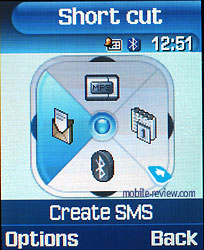 
The interface changes did not occur solemnly around the menu arrangement; the alterations of bigger importance took place as well. Many would recall, that in previous Samsung models predictable T9 text input was always on and had to be switched off all the time - quite an irritating procedure you would acknowledge. D500 doesn't have this problem - the phone remembers your last entry. Moreover, while typing in a text, there is an option to switch quickly local English setting.
Phone book.
By pressing the right soft key, one can obtain the contacts in a form of a list containing all the files both from the phone's and the SIM-card memory. The first name in the list is backlit by default and the number is shown in the status bar (there is a special sign for numbers from a SIM-card). There is a fast search by first letters of a name; the phone can hold more than twenty of those for any possible language. By pressing the OK key, you enter in the view menu of a single file where you may see a small icon in case the name is matched with the image. Any graphic file or the pictures of your own may be used as such image. Up to five phone numbers of various types (cell, office, home, fax, etc.) may be kept for a name with one number as the main contact (it would become the first one by default). The margins are strictly fixed and there may be not two cell phone numbers entered. On the other hand, SMS/MMS can be sent to any number from the phone book once chosen.
 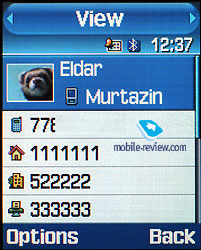
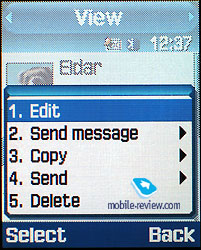 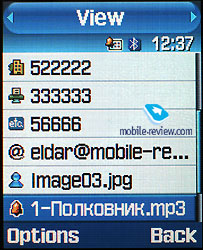
 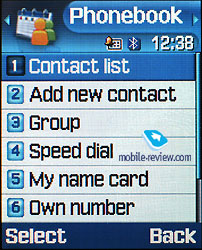
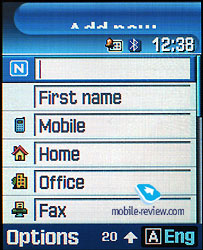 
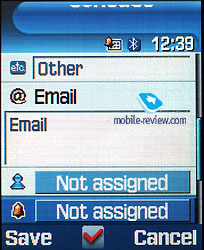 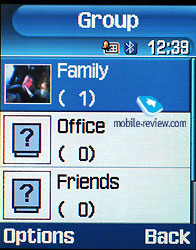
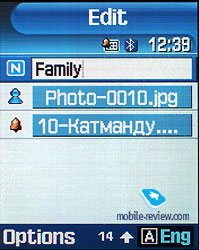 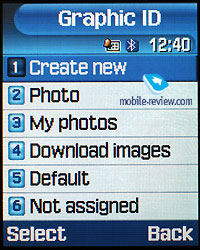
 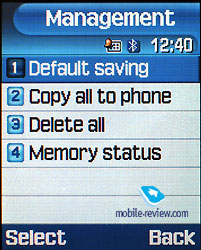
While displayed, the margins for the first and the last name (the search is conducted for the first margin only) are joined and the Name margin goes first. For example, Eldar Murtazin is displayed exactly in this manner. The length of each margin is 20 symbols for any of the offered languages. You may opt to alter the languages while inserting the text as well.
Files in different languages are sorted out according to a rule - first it will be all files in the local language (Russian, for example), and then those in English. This is rather convenient and habitual due to the computer programs. Taking into account an option of fast language change during the search it becomes clear that the files in different languages do not impede the work with this phone.
Let us return to the information entered for one name. Besides phone numbers, an e-mail address and a little text memo can be recorded. Any music file as well as the mp3 compositions can be chosen as a ring tone for the name. The phone offers three groups of subscribers and one 'out of any group' category. The needed number of groups, the ring tones and the pictures for them can be created very easily.
Up to 1000 names with all the data can be saved in the phone's memory. Even if not all the margins are occupied, the number of names to be saved would remain a thousand. It is possible to indicate in the Settings where the new numbers should be kept by default. There is an option of moving files from the SIM-card although not vice versa. According to the developers, PC is the best means of synchronization, MS Outlook in particular. Any file in the form of SMS/MMS, mail message or else through Bluetooth and IrDA can be quickly sent to another device. There are no problems with delivery and the file is being transmitted to another device and precisely decoded without any trouble.
New files can be entered only through the main menu; the first soft key always calls for the name list only. You can create your own morning coat; its format would be the one of a regular file from the phone book.
There might be up to eight numbers in the speed dial list; peculiar is the fact that separate numbers of one name may be in this list as well. The subtitle of the chosen name (but not of the phone type) is displayed on the buttons.
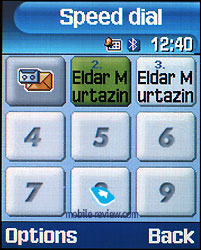
The comparison of this phone book with phone books of other phones is rather interesting. It is not fully compatible with the MS Outlook margins; the phone has fewer margins. Consequently, the phone gives way to all the smartphones (the phone book options are the most extended ones in those). The phone book is moderate here when compared to the phones such as Siemens and Alcatel. However, the model is a decent rival to all other phones. The phone also has a very convenient phone book, which is a pleasure to work with.
At an incoming call, a picture is not displayed on the full screen, but only on a part of it (approximately 120x140 pixels). In a way, this stands for the phone's disadvantage, however the developers may ameliorate this shortcoming in a time span. Being familiar with the Samsung Company it might be assumed that the ameliorations occur when the next model, not D500, comes out.
Another serious disadvantage of this phone is the lack of voice recognition. Users of a Bluetooth-headset and an in-car speakerphone are particularly interested in this function. The lack of the voice recognition in the phone of this class although being very unusual however was a conscious move in this case. It's true, that very few owners of fashion phones use voice recognition, even though it is in a big demand in the business world. In some way here the logic of the previously taken decisions occurred.
Call lists.
Up to twenty phone numbers are displayed in each list. There is a combined list of all the last calls with an icon indicating a call type. Tilting the scroll key horizontally, you may switch quickly from one list to another. Working so, the date and the time of the call (it is duration is not kept) can be seen for a separate file. As always, the overall time of the calls and their prices can be viewed in this menu (this service has to be installed).
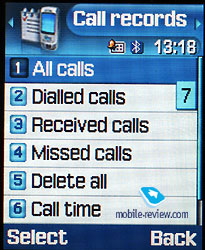 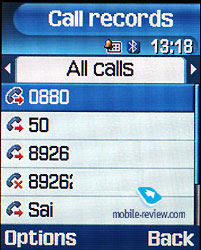
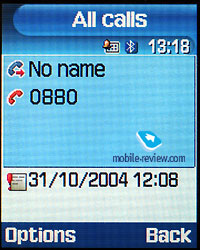 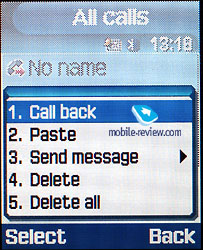
Applications.
Java World is the first menu file; up to four MB of memory are available in the phone for various programs. This is a separate memory slot and is used for Java only. MIDP 2.0 version allows the use of the graphically reach and three-dimensional games. Three games, Forgotten Warrior, Freekick, and ArchAngel are offered in the phone. In the first game the player wanders around labyrinths, collects items of different natures and fights the guards. The game is well know to PC users and is rather amusing. The second game is soccer - all you have to do is to score. The conditions of this game, such as the wind direction and the goalie behavior, are very interesting. Third game is a typical arcade in which you just have to destroy all the enemies' airplanes and escape from their fire.
 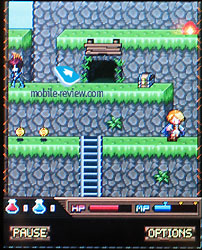 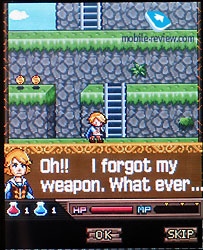
 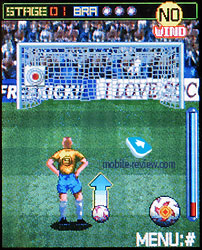
 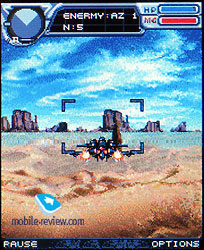
MP3 player.
An integrated mp3 player supporting accidental track reproduction, both sequential and cyclic, is available in the phone. Mp3 files can be downloaded into the phone both directly through Bluetooth and through a synchronization program. Files may be of various names and tags (in Russian language as well!). The beat rate of the files is not that important since the phone accepts all the possible formats. We came across several problems with the files recorded through VBR since the phone would report an error and reject downloading. However, a number of the same VBR mp3 files were successfully downloaded and reproduced without any problem.
The name of the track playing is displayed as well as the overall number of different composition. An equalizer is of an entertaining nature; there are no separate settings. The tracks can be played through the stereo headset as well as through the speakerphone. The volume is of ten divisions. The user is welcome to create play lists of his/her own. Somewhat 94 MB of the memory are kept for the mp3 compositions, which is good for more than one and a half hours of music recordings of a decent quality. The player in this model is simple and does not differ from other models.
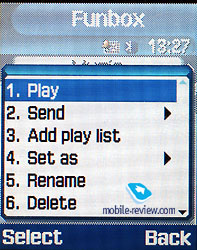 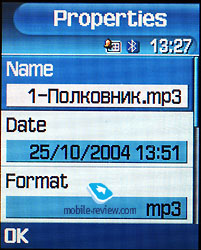
 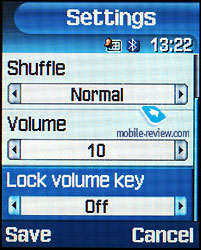
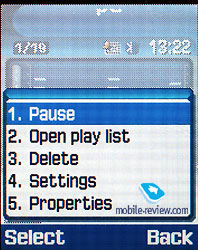 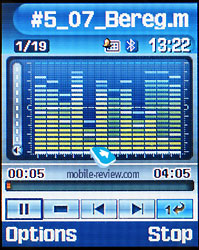
Dictaphone.
You can record up to several hours of voice memos with the number of files being unlimited. The time restrictions for one recording are set by a user and can vary from 30 seconds to one hour in duration. All the files are kept in a separate folder in the memory. The dictaphone would not record the conversation since it turns on only in the stand by mode. Two types of equalizers are offered in the settings with one of them meant for the noisy surroundings. The recorder can function well during the lectures, conferences, and presentations. The phone is a partial substitute for a digital tape recorder.

World time is displayed for two chosen cities. Everything is nice and simple here.

Alarm clock. The phone is equipped with three alarm clocks. One is meant for mornings and can be set for selected weekdays as well as for weekends. For each of the alarm clocks there is a selection of five melodies although mp3 compositions cannot be used here. It is up to a user to indicate in the settings whether the phone would turn on automatically in the time of the event or not.
 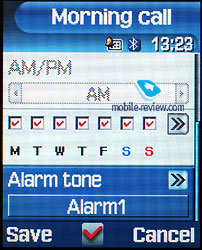
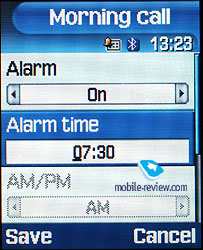
Calculator. Everything is nice and simple here.
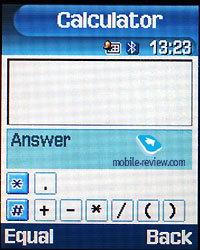
With a converter, you can operate with different units of measurements as well as with the currencies.
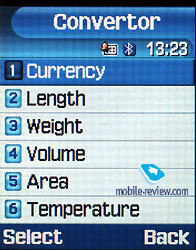 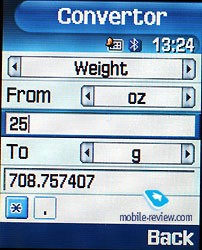
Countdown timer. The time can be displayed in both hours and minutes; the clock can be used as a background.
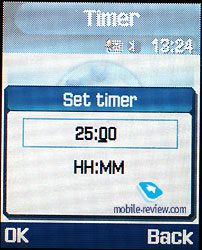
You can request the intermediate result with a stopwatch.
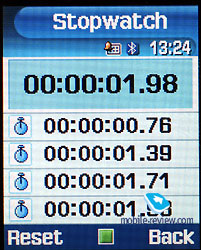
Funbox.
All the 'fun' files, such as music, images, videos, and sound are kept here. All the downloaded files are transmitted here. One disadvantage here is that sometimes the file is not immediately displayed in the general list and a user has to exit and open the list anew.
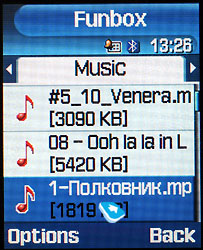 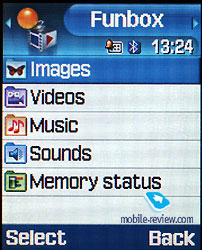
Messages.
Work with different types of messages is done through separate submenus. Let us begin with short messages. Up to 200 messages can be saved in the phone's memory; the phone supports the EMS standard compatible with Nokia Smart Meassaging. The support of various encodings chosen by a user (GSM or Unicode) is a very nice feature here. Talking of a unique functions, a 'black list' is available. The numbers from this list available for ten phones would not be shown. T9 functions very well and provides good and easy service.
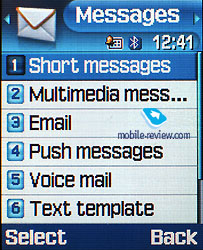 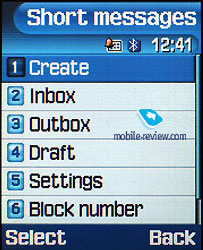
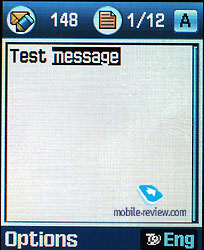 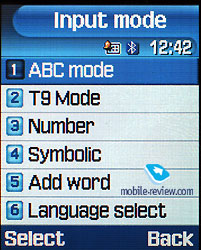
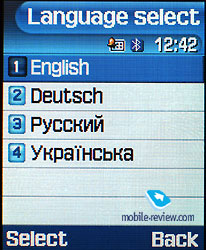 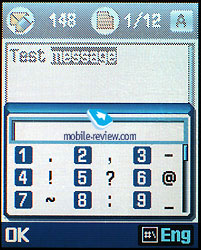
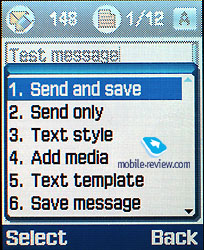 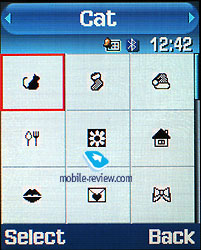
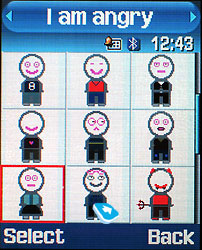 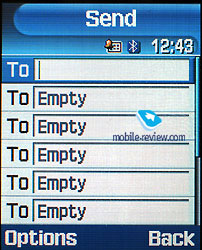
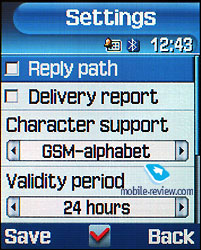 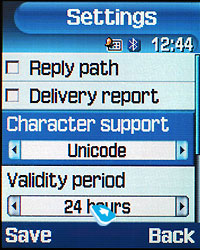
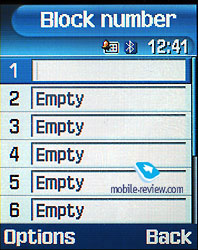
MMS.
The interface for the multimedia messages is very nice; the messages can be saved in several folders at once and right away. There are no size restrictions for a message to be received although a message should not exceed 295 KB. As for additional services, the rejection of advertising messages, the option of the message receipt in the roaming and the home network should be mentioned. The messages are saved in the general memory since there is no special memory for them.
 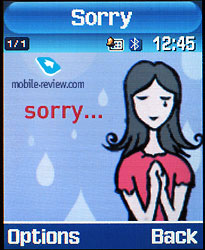
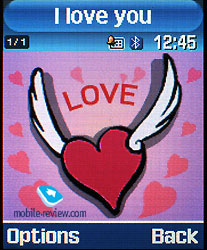 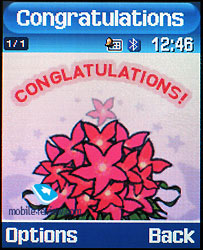
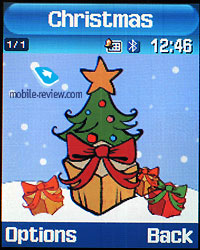 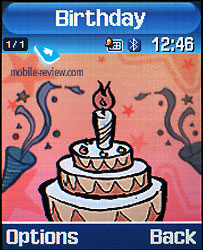
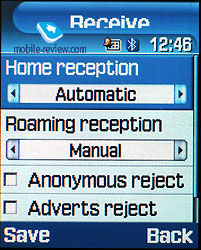
Mail client. POP3/SMTP boxes and several tracking files are supported. Besides the title downloading, the phone can receive the letter itself. As for attachments, only the graphic files (GIF, JPEG) are supported. When sending out a letter, you attach a picture from the integrated camera to it. Overall, the mail client is nice although not standing out for the immense number of functions. There is an option of creating templates.
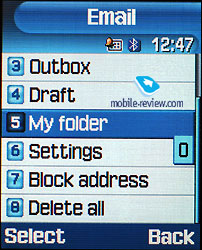
Organizer.
Up to 400 events of four types - meeting, affair, anniversary and others, can be saved in the phone's memory. The day and the time as well as its end are indicated for each file. A signal can be set for the interval during which it has to go off; repetitive events are available for setting.
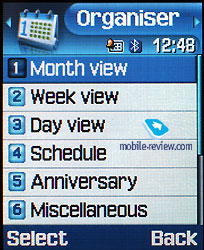 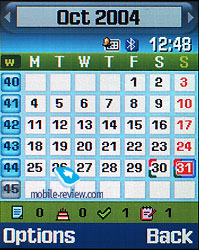
 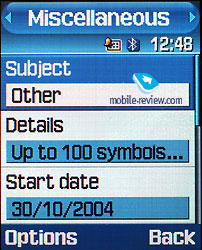
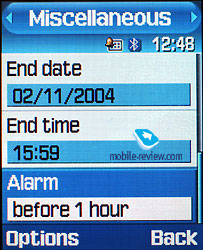 
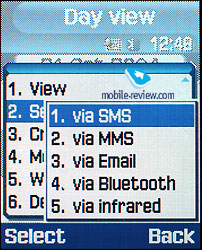 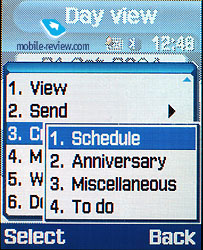
 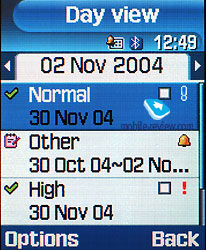
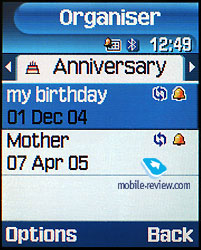 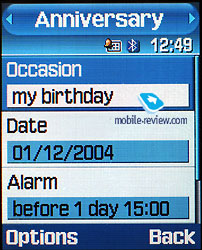
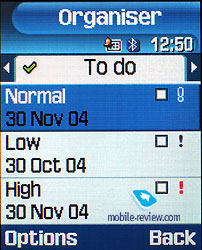
The weekly and the monthly calendar are very convenient with each type of the event having its own color.
The user can as well create up to 50 text memos each 100 symbols in length. There are neither signals nor warnings for these files.
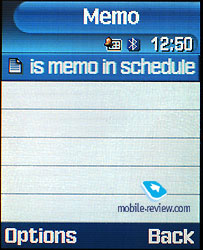 
The phone settings, Bluetooth, memory, price policy and several other aspects are to be discussed in the next part of the review.
Review Samsung D500. Part I >>>
Review Samsung D500. Part III >>>
Review Samsung D500 camera>>>
Eldar Murtazin ([email protected])
Translated by Maria Kapustina ([email protected])
Published — 10 November 2004
Have something to add?! Write us... [email protected]
|

















































































